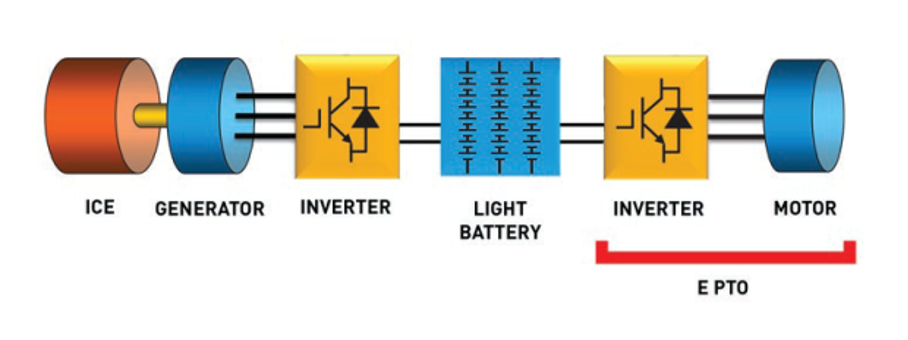What is an Electric Power Take-Off (ePTO)?
When does the electrification of large, mobile machines become profitable? With the use of an ePTO, heavy-duty applications comply with regulations concerning noise and emissions. Proper component selection also makes these applications economically appealing. In this article, we delve into the ePTO, its operation, and discuss its application in concrete mixers, garbage trucks, and crane trucks. Learn when it makes sense for a machine builder to employ an ePTO alongside a traditional internal combustion engine in your application.
Regulations strongly drive the electrification of all vehicles used in urban environments. This is intended to reduce exhaust emissions and noise pollution. However, many equipment manufacturers find transitioning to a full electric drive too significant of a leap. As a result, they often opt for a split-drive solution, distributing power between the so-called traction and work functions, which involve machine movement and operating auxiliary equipment. The vehicle continues to be propelled by an internal combustion engine, but an ePTO drives the auxiliary equipment.
What is ePTO
An Electric Power Take-Off (ePTO) is the ability to deliver electric power to a power take-off shaft, using mechanisms like a hydraulic pump. By combining this with a battery, an ePTO facilitates more efficient energy usage (the engine doesn’t need to run when the power take-off is active), improved performance, and reduced noise levels. It’s particularly suitable for applications active in urban environments, such as construction cranes, garbage trucks, and concrete mixers. Previously, such applications used a Power Take-Off (PTO) driven directly by an internal combustion engine.
An ePTO system comprises an inverter that drives an electric motor, with the inverter being powered by a DC (Direct Current) energy source like a battery. Below are two illustrations of how this is practically implemented:
- Rechargeable battery that’s charged, for instance, during the night (using green energy or at a low energy tariff rate).

- Charging through the combustion engine (while moving the application), use of stored energy during standstill.

The second scenario, for example, applies to a garbage truck. The battery charges while driving, and the power is used to operate the crane and compaction machinery. The advantage here is that a smaller, lighter battery can be used, and it’s also more cost-effective than the first solution where all functions must be accomplished on a single battery charge.
Optimal ePTO Motor
For many equipment manufacturers, the first step towards electrification involves replacing the internal combustion engine-driven PTO with an electric PTO. At the same time, there are opportunities for further efficiency improvement through better component selection, as is the case with the motor. A regular air-cooled 110 kW induction motor is outperformed by a Permanent Magnet AC (PMAC) synchronous motor, such as those from Parker. Consider the Parker GVM210 400 motor with 136 kW, which is just a twentieth of the size and a tenth of the weight, while the power density and speed capabilities in combination with an inverter can precisely deliver the optimal speed and torque to maximize performance from the electro-hydraulic pump. Moreover, the efficiency is significantly better, making it possible to use a lighter, more affordable battery and overall making the ePTO solution more appealing.
2 ePTO Applications in Construction
Apart from the garbage truck, there are two more applications that greatly benefit from the ePTO solution: a crane truck and a concrete mixer.

A truck with a loading crane has two tasks for its propulsion: driving the truck to its destination and subsequently loading and unloading heavy materials. By utilizing a battery-powered ePTO during loading, the internal combustion engine can be switched off, enabling the application to be used in environments like warehouses due to the absence of exhaust emissions. Here as well, proper component selection significantly contributes to the efficiency and cost of the application.
The concrete mixer presents a much more challenging usage profile, requiring relatively high torque for tasks like mixing concrete, transporting it to the construction site, and pumping throughout the cycle. In this demanding application, the right battery, inverter, and motor selection make all the difference in terms of (cost) efficiency. An overly “heavy” solution brings unnecessary weight and costs. An efficient ePTO solution ensures that the engine doesn’t need to run on the construction site, leading to improved working conditions for employees and reduced noise disturbance for nearby residents.
By directly connecting the gearbox responsible for driving the rotation of the concrete mixer to the ePTO, the hydraulic circuit becomes unnecessary. This enhances efficiency and reliability while reducing the maintenance requirements of the application.
Why ePTO
Anticipated or impending changes in laws and regulations make electrification seem inevitable, even for large mobile machines that were previously unaffected. Fortunately, this also presents significant opportunities for equipment manufacturers. Through proper component selection, an electrified power take-off (ePTO) becomes profitable, while the right hydraulic system can deliver the necessary mechanical force for critical functions.
Are you working on electrification or exploring its possibilities? Look no further than VARIODRIVE. Our years of practical experience with these types of solutions allow us to make rapid progress together and provide you with a clear understanding of the possibilities. Schedule an appointment via sales@variodrive.nl or call 0186-636280.
